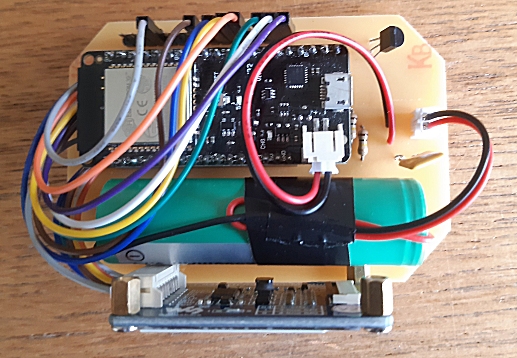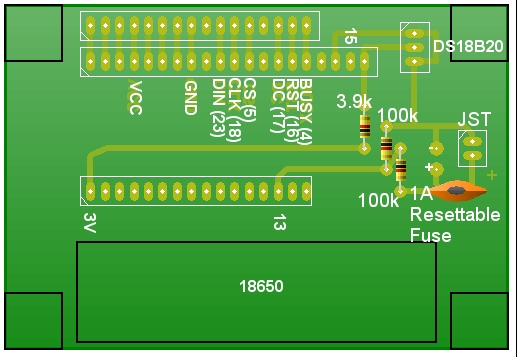PCB Artwork in PCB Wizard format.
PCB Wizard Website
Setting up the Arduino IDE
If you haven't used the ESP32 in the Arduino environment before, it's necessary to install the ESP32 Board definitions into the Arduino IDE.
In the Arduino IDE, select File -> Preferences.
In the Additional Boards Manager URLs text box, enter: https://dl.espressif.com/dl/package_esp32_index.json then click the OK button. If another entry is already in the Additional Boards Manager URLs text box, separate them with a comma (,).
Select Tools -> Board -> Board Manager...
Wait for the platforms index to download then scroll down the list to esp32 and click Install.
Close the Arduino IDE.
Copy the Arduino sketch below and paste it into the IDE.
Find the following four lines near the top of the sketch, edit them to your own WiFi SSID, WiFi Password, your PC's Network address,
the Port number and Device ID you've selected for this project and upload the sketch to the ESP32 WeMos LoLin32.
const char* ssid = "**********"; // Your router's WiFi SSID
const char* password = "**********"; // Your router's Wifi Password
String serverIP = "192.168.1.3:8835"; // Your PC's network address and the port
// you've chosen for this project.
String device_id = "room"; // The device ID for this project.
The Arduino Sketch
#include <GxEPD.h>
#include <GxGDEH0154D67/GxGDEH0154D67.h> // 1.54" b/w epaper display
#include <GxIO/GxIO_SPI/GxIO_SPI.h>
#include <GxIO/GxIO.h>
#include <Fonts/FreeSansBold18pt7b.h>
#include <OneWire.h>
#include <DallasTemperature.h>
#include <WiFi.h>
#include <HTTPClient.h>
#define ONE_WIRE_BUS 15
#define VOLTS_PIN 13
OneWire oneWire(ONE_WIRE_BUS);
DallasTemperature sensors(&oneWire);
// Waveshare e-paper connections to ESP32
// Vcc -> 3v
// GND -> GND
// DIN -> MOSI (GPIO 23)
// CLK -> CLK (GPIO 18)
// CS -> SS (GPIO 5)
// DC -> GPIO 17
// RST -> GPIO 16
// BUSY-> GPIO 4
GxIO_Class io(SPI, /*CS=5*/ SS, /*DC=*/ 17, /*RST=*/ 16); // arbitrary selection of 17, 16
GxEPD_Class display(io, /*RST=*/ 16, /*BUSY=*/ 4); // arbitrary selection of (16), 4
RTC_DATA_ATTR float previous_temperature = 0.0; // This variable's value is retained when
// the ESP32 resets.
const char* ssid = "**********"; // Your router's WiFi SSID
const char* password = "**********"; // Your router's Wifi Password
String serverIP = "192.168.1.3:8835"; // Your PC's network address and the port
// you've chosen for this project.
String device_id = "room"; // The device ID for this project.
int sleep_interval = 5; // minutes to wait between temperature measurements.
int retry_interval = 1; // minutes to wait before retrying to connect WiFi.
boolean METRIC = true; //Set true for celcius; false for fahrenheit.
float temperature = 0.0;
float mVolts = 0.0;
long rssi;
float getTemperatureFromSensor(){
sensors.requestTemperatures();
if(METRIC) {
temperature = sensors.getTempCByIndex(0);
}else {
temperature = sensors.getTempFByIndex(0);
}
temperature = round(temperature * 10) / 10;
return temperature;
}
void setup() {
sensors.begin();
int vref = 1100;
uint16_t v = analogRead(VOLTS_PIN); // Read adc value at R1/R2 junction
float mVolts = ((float)v / 4095.0) * 2 * 3.2 * vref; // Convert value to mVolts.
temperature = getTemperatureFromSensor(); // Get temperature from DS18B20
WiFi.begin(ssid, password); // Start the WiFi connection.
int wifi_timeout = 0; // Attempt to connect
while (WiFi.status() != WL_CONNECTED) {
delay(10);
wifi_timeout++;
if (wifi_timeout > 1000) { // Connect to WiFi failed - deep sleep...
deepSleep(retry_interval); // .. for the retry interval.
}
}
if (WiFi.status() == WL_CONNECTED) { // WiFi connected to router.
rssi = WiFi.RSSI(); // Get WiFi signal strength.
HTTPClient http; // Create an HTTP Client instance.
// Specify the HTTP request's destination, including port and your GET variables
String http_request = "";
http_request = "http://" + serverIP + "/?";
http_request += "id=" + device_id;
http_request += "&leftaxis=" + String(temperature);
http_request += "&rightaxis=" + String(mVolts);
http_request += "&rssi=" + String(rssi);
http_request += "&interval=" + String(sleep_interval);
http.begin(http_request);
// Send the request
int httpCode = http.GET();
// Check the returning HTTP code
if (httpCode > 0) {
// Get a response back from the server
String payload = http.getString();
}
// Close the HTTP connection
http.end();
}
if (abs(previous_temperature - temperature) > 0.1 ) { // If the temperature has changed by
// more than 0.1 degrees, then update display.
previous_temperature = temperature;
display.init();
display.setRotation(45);
display.setTextColor(GxEPD_BLACK);
display.fillScreen(GxEPD_WHITE);
display.setTextSize(2);
display.setCursor(20, 10);
display.print("TEMPERATURE C");
display.setCursor(10, 180);
display.print(mVolts / 1000, 2);
display.print("v");
display.setCursor(120, 180);
display.print(rssi);
display.print("dB");
display.setFont(&FreeSansBold18pt7b);
display.setCursor(30, 120);
display.print(temperature, 1);
display.update();
}
deepSleep(sleep_interval);
}
void deepSleep(int interval) {
esp_sleep_enable_timer_wakeup(interval * 60 *1000 * 1000);
esp_sleep_pd_config(ESP_PD_DOMAIN_MAX, ESP_PD_OPTION_OFF);
esp_sleep_pd_config(ESP_PD_DOMAIN_RTC_PERIPH, ESP_PD_OPTION_OFF);
esp_deep_sleep_start();
}
void loop() {
// Nothing to see here.
}






